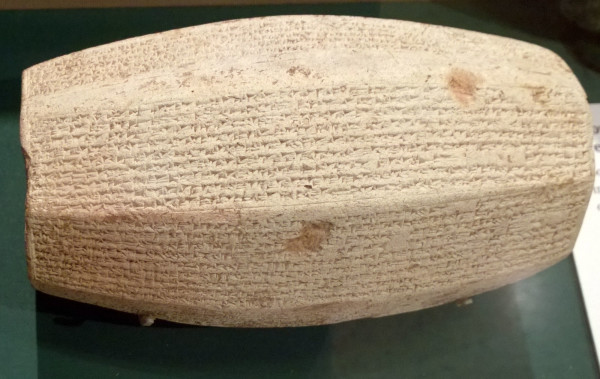Among the ancient cities ISIS bulldozed and blasted this past March was Dur-Sharrukin (modern Khorsabad in Iraq), a capital city founded by Assyrian King Sargon II (r. 722-705 BC). Like all ancient Assyrian kings, Sargon left a clear warning to those who destroyed his work.
Safe from destruction was a 9-sided prism describing Sargon’s founding of Dur-Sharrukin. The following breaks down the contents of the prism’s inscriptions as well as clear warning to ISIS from Sargon.

While the modern world celebrates Sargon as an ancient ruler and military colleges study his campaigns, the king saw himself in a much different light. The prism tells us that Sargon was: ((Translations come from Daniel David Luckenbill, ed., Ancient Records of Assyria and Babylonia (London: Histories & Mysteries of Man, 1989), 2:60-66.))
- the great king
- the mighty king
- king of the universe
- king of Assyria
- king of the world
- favorite of the great gods
- rightful ruler
- the brave warrior
If that is not enough, Sargon was the “mighty hero, clothed with terror, who sent forth his weapon to bring low the foe.” In war, he tell us that he:
- opened up the mighty mountain regions whose passes were difficult and countless
- advanced over inaccessible paths
Then there is a lengthy description of how he subdued just about every known power at the time. Some he spared. Others he destroyed, depending on their resistance and past offenses.
Assyrian kings almost fall over themselves to pay tribute to their predecessors while warning descendants to take care of what they built. In several instances, kings described how they restored temples and cities that fell into disrepair. Sargon was no different. Here, “the sagacious king, full of kindness” lists all the towns and regions he restored.
Finally, he established Dur-Sharrukin.
Sargon II’s Warning
After a lengthy inscription describing the work that went into the city, there is a warning to anyone who would undo the work.
Whoever destroys the work of my hands, injures my statue, brings to naught the law which I have established or blots out the record of my honors, may Assur, Shamash, Adad and the great gods who dwell therein, destroy his name and his seed from the land, may they set him in chains under the heel of his foe.
These were more ancient cities, all associated with Assyrian deities. This type of warning is common throughout inscriptions of the Babylonian and Assyrian period, as are the detailed descriptions of the king, his conquests, and restorations.
After 2,700 years, someone has systematically ignored Sargon’s warning and destroyed his capital city. The great king, the mighty king, the king of the universe rolls over in his grave.
